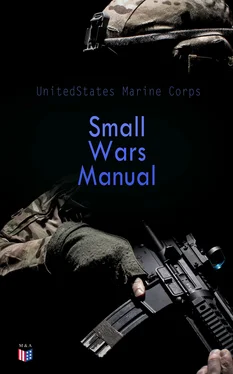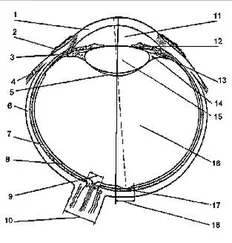SECTION III COMPOSITION OF THE FORCE
2-38. General.
2-39. Infantry.—a. Importance.
2-40. Infantry weapons.
2-41. Infantry individual equipment.
2-42. Mounted troops.
2-43. Engineers.
2-44. Tanks and armored cars.
2-45. Transport.
2-46. Signal troops.
2-47. Chemical troops.
2-48. Medical troops.
2-49. Artillery.
2-50. Aviation.
CHAPTER III LOGISTICS
SECTION I INTRODUCTION
SECTION II SUPPLY
3-2. Influence of Supply on a column.
3-3. Supply officers.
3-4. Storage.
3-5. Distribution.
3-6. Supply steps.
3-7. Local purchases.
3-8. Requisitions.
3-9. Depots, dumps, and distributing points.
3-10. Chain of responsibility.
3-11. Accountability.
3-12. Public funds.
3-13. Objective.
3-14. Supervision of requisitions.
3-15. Accumulation of stores.
3-16. General.
3-17. Importance of supply.
SECTION III TRANSPORTATION
3-18. General.
3-19. Railroad transportation.
3-20. Motor transportation.
3-21. Tractor-trailer transportation.
3-22. Transportation pools.
3-23. Aviation transport.
3-24. Water transportation.
3-25. Animal transpdrtation.
3-26. Important points in packing.
3-27. Pack mules.
3-28. Pack horses.
3-29. Pack bulls.
3-30. Phillips pack saddle.
3-31. McClellan saddle.
3-32. Pack equipment.
3-33. Native packers.
3-34. Marines as packers.
3-35. Bullcarts.
3-36. Trains with combat columns.
CHAPTER IV TRAINING
SECTION I CHARACTER AND PURPOSE OF SMALL WARS TRAINING
4-1. Relation to other training.
4-2. Tactical training.
4-3. Rifle company.
4-4. Machine gun company.
4-5. Mortars and 37 mm. guns.
4-6. Troop schools.
SECTION II TRAINING DURING CONCENTRATION
4-7. Training objective.
4-8. Scope of training.
4-9. Disciplinary training.
SECTION III TRAINING EN ROUTE ON BOARD SHIP
4-10. General.
4-11. Ship routine.
4-12. Time available for troop training.
4-13. Troop schools on board ship.
4-14. Size of classes.
4-15. Assignment to classes.
4-16. Subjects covered.
4-17. Essential training.
SECTION IV TRAINING IN THE THEATER OF OPERATIONS
4-18. System of training.
4-19. Facilities.
4-20. Subjects covered.
4-21. Training centers.
4-22. Troop schools.
4-23. Organization of troop schools and training centers.
SECTION V Training Instructions
4-24. Training instructions.
4-25. Training programs.
4-26. Training schedules.
CHAPTER V INITIAL OPERATIONS
SECTION I NEUTRAL ZONES
5-1. General.
5-2. Purpose, occasion, and circumstances.
5-3. Basic orders.
5-4. Instructions.
5-5. Zone force commander’s order.
5-6. Proclamation.
SECTION II MOVEMENT INLAND
5-7. Point of departure.
5-8. Mobile columns and flying columns.
5-9. Strength and composition of columns.
5-10. Protective measures covering movement.
5-11. Establishment of advanced bases inland.
5-12. Movement by rail.
SECTION III MILITARY TERRITORIAL ORGANIZATION
5-13. Purpose.
5-14. Influence of the mission on territorial organization.
5-15. Assignment of troops to areas.
5-16. Size and limits of areas.
SECTION IV METHODS OF PACIFICATION
5-17. The nature of the problem.
5-18. Methods of operations.
5-19. Occupation of an area.
5-20. Patrols.
5-21. Roving patrols.
5-22. Zones of refuge.
5-23. The cordon system.
5-24. The Blockhouse system.
5-25. Special methods.
CHAPTER VI INFANTRY PATROLS
SECTION I SMALL WAR TACTICS
6-1. Tactics during initial phases.
6-2. Tactics during later phases.
6-3. Influence of terrain.
6-4. The principle of the offensive.
6-5. The principles of mass, movement, surprise, and security.
SECTION II ORDERS AND GENERAL INSTRUCTIONS
6-6. Written orders.
6-7. Verbal orders.
6-8. General instructions.
SECTION III ORGANIZING THE INFANTRY PATROL
6-9. Definition.
6-10. Factors which govern its organization.
6-11. Size of the patrol.—a. General.
6-12. Permanent roving patrols.
6-13. Selection of units.
6-14. Elimination of the physically unfit.
6-15. Patrol and subordinate leader.
6-16. The rifle squad.
6-17. The headquarters section.
6-18. Attached units.
6-19. Guides and interpreters.
6-20. Native transport personnel.
6-21. Native troops.
6-22. Prominent native civilians.
6-23. Transportation.
6-24. Weapons.
6-25. Ammunition.
6-26. Signal equipment.
6-27. Medical supplies.
6-28. Miscellaneous equipment.
6-29. Personal clothing and accessories.
6-30. General preparations.
SECTION IV FEEDING THE PERSONNEL
6-31. Responsibility of patrol leader.
6-32. Mess equipment.
6-33. Weight of rations.
6-34. The field ratioit.
6-35. Butchering on the march.
6-36. Feeding native personnel.
6-37. Emergency rations.
SECTION V THE MARCH
6-38. General.
6-39. Hour of starting.
6-40. Rate of inarch.
6-41. Factors influencing march formations.
6-42. Influence of terrain on march formation.
6-43. Road spaces.
6-44. Location of patrol and subordinate leaders in march formation.
6-45. Location of the combat train.
6-46. Descriptive march formations.
6-47. March formations for a reenforced rifle company.
6-48. March formation for a reenforced rifle platoon.
6-49. March formation for a rifle platoon.
6-50. March formation for a rifle squad.
6-51. March discipline.
6-52. March outposts.
6-53. Camp sites.
6-54. Making camp.
6-55. Shelter.
6-56. Bivouac beds.
SECTION VI RECONNAISSANCE AND SECURITY
6-57. Methods of reconnaissance.
6-58. Reconnoitering by scouts.
6-59. Careful visual reconnaissance.
6-60. Hasty visual reconnaissance.
6-61. Reconnaissance by fire.
6-62. Reconnaissance by aviation personnel.
6-63. Airplane reconnaissance by patrol leaders.
6-64. Intelligence agents.
6-65. Questioning inhabitants for information.
6-66. Dogs on reconnaissance.
6-67. Security on the march.
6-68. Security at rest.
SECTION VII LAYING AMBUSHES
6-69. Definition.
6-70. Selection of position.
6-71. Usual characteristics of an ambush.
6-72. Occupying the position.
6-73. The ambush engagement.
6-74. Employment of infantry weapons.
SECTION VIII ATTACKING AMBUSHES
6-75. Mental preparation.
6-76. Prearranged schemes of maneuver.
6-77. Spirit of the offensive.
6-78. Fire and movement.
6-79. Authority of subordinates to act on own initiative.
SECTION IX ATTACKING HOUSES AND SMALL BIVOUACS
6-80. Attacking houses.
6-81. Attacking small bivouacs.
6-82. Destroying captured bivouacs.
SECTION X STRATAGEMS AND RUSES
6-83. Rules of land warfare.
6-84. Clearing the station.
6-85. Apprehending informers.
6-86. Spies following a patrol.
6-87. Guerrilla ruses and stratagems.
SECTION XI RIVER CROSSINGS
6-88. Introduction.
6-89. Availability of means.
6-90. Swimming.
6-91. Bridges.
6-92. Boats.
6-93. Ferries.
6-94. Fords.
6-95. Rafts.
6-96. Crossing unfordable streams with usual infantry equipment.
6-97. Crossing horses and mules.
SECTION XII SPECIAL OPERATIONS
6-98. Trail cutting.
Читать дальше












